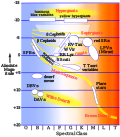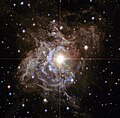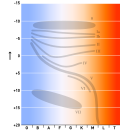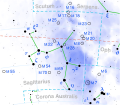Classical Cepheids are a type of Cepheid variable star. They are young, population I variable stars that exhibit regular radial pulsations with periods...
40 KB (3,964 words) - 10:05, 30 May 2025
A Cepheid variable (/ˈsɛfi.ɪd, ˈsiːfi-/) is a type of variable star that pulsates radially, varying in both diameter and temperature. It changes in brightness...
38 KB (4,309 words) - 20:55, 25 May 2025
Period-luminosity relation (category Classical Cepheid variables)
pulsating variable stars with their pulsation period. The best-known relation is the direct proportionality law holding for Classical Cepheid variables, sometimes...
20 KB (2,319 words) - 22:03, 24 May 2025
Polaris (category Classical Cepheid variables)
Population I classical Cepheid variable, although it was once thought to be a type II Cepheid due to its high galactic latitude. Cepheids constitute an...
53 KB (5,092 words) - 16:46, 15 June 2025
W Virginis variables are a subclass of Type II Cepheids which exhibit pulsation periods between 10–20 days, and are of spectral class F6 – K2. They were...
2 KB (202 words) - 21:12, 15 June 2024
V Centauri (category Classical Cepheid variables)
V Centauri (V Cen) is a Classical Cepheid variable, a type of variable star, in the constellation Centaurus. It is approximately 2,350 light-years (720...
7 KB (646 words) - 23:37, 14 January 2025
of the class of Cepheid variables. However, the namesake for classical Cepheids is the star Delta Cephei, discovered to be variable by John Goodricke...
51 KB (6,578 words) - 23:22, 23 May 2025
have supergiant luminosity classes, for example α Herculis. Classical Cepheid variables typically have supergiant luminosity classes, although only the...
40 KB (5,378 words) - 22:07, 13 May 2025
V1334 Cygni (category Classical Cepheid variables)
naked eye of an observer located far from city lights. It is a classical Cepheid variable star, ranging in brightness from magnitude 5.77 to 5.96 over a...
11 KB (947 words) - 19:00, 11 May 2025
S Vulpeculae (category Classical Cepheid variables)
an RV Tauri variable, a semiregular variable star, or a Cepheid variable. S Vulpeculae is now confirmed as a classical Cepheid variable with one of the...
6 KB (557 words) - 17:55, 3 June 2025
Milky Way. He used the strong direct relationship between a classical Cepheid variable's luminosity and pulsation period (discovered in 1908 by Henrietta...
50 KB (5,132 words) - 01:35, 3 June 2025
V473 Lyrae (category Classical Cepheid variables)
V473 Lyrae is a variable star in the constellation Lyra. It is an unusual Classical Cepheid variable with a visual range of 5.99 to 6.35. V473 Lyrae is...
9 KB (795 words) - 19:49, 4 May 2025
OGLE-LMC-CEP0227 (category Classical Cepheid variables)
eclipsing binary and Cepheid variable star, pulsating every 3.8 days. The star, in the Large Magellanic Cloud, was the first Cepheid star system found to...
7 KB (509 words) - 12:30, 23 August 2024
X Crucis (category Classical Cepheid variables)
X Crucis is a classical Cepheid variable star in the southern constellation of Crux. X Crucis is a pulsating variable star with am extremely regular amplitude...
7 KB (546 words) - 12:46, 14 May 2023
The variables follow a period-luminosity relation in certain passbands like other standard candles such as Cepheids. and, together with classical cepheids...
11 KB (913 words) - 16:07, 21 February 2025
Beta Doradus (category Classical Cepheid variables)
brightest star in the southern constellation of Dorado. It is a Classical Cepheid variable, with an apparent magnitude that varies between 3.46 and 4.08...
11 KB (806 words) - 20:47, 12 February 2025
HD 95109 (category Classical Cepheid variables)
a Classical Cepheid variable, a type of variable star, in the constellation Carina. Its apparent magnitude is 6.86. U Car is a δ Cepheid variable with...
7 KB (614 words) - 00:24, 9 January 2025
Type II Cepheids are variable stars which pulsate with periods typically between 1 and 50 days. They are population II stars: old, typically metal-poor...
13 KB (1,231 words) - 23:09, 28 April 2025
and BL Herculis variables, the type II Cepheids. Classical Cepheid variables are higher mass population I stars. RR Lyrae variables are much more common...
20 KB (2,350 words) - 02:47, 18 April 2025
Delta Cephei (category Classical Cepheid variables)
the prototype of the Cepheid variable stars that undergo periodic changes in luminosity. Delta Cephei was discovered to be variable by John Goodricke during...
21 KB (1,806 words) - 19:45, 27 April 2025
Zeta Geminorum (category Classical Cepheid variables)
— in its south, on the left 'leg' of the twin Pollux. It is a classical Cepheid variable star, of which over 800 have been found in our galaxy. As such...
22 KB (2,220 words) - 00:25, 19 May 2025
Y Carinae (category Classical Cepheid variables)
Y Carinae (Y Car) is a Classical Cepheid variable, a type of variable star, in the constellation Carina. Its apparent magnitude varies from 7.53 to 8.48...
7 KB (646 words) - 01:56, 12 January 2025
FF Aquilae (category Classical Cepheid variables)
FF Aquilae is a classical Cepheid variable star located in the constellation Aquila, close to the border with Hercules. It ranges from apparent magnitude...
10 KB (930 words) - 19:32, 16 July 2024
S Normae (category Classical Cepheid variables)
supergiant variable star in the constellation Norma. It is the brightest member of the open cluster NGC 6087. S Normae is a Classical Cepheid variable with...
8 KB (612 words) - 05:13, 1 December 2023
V636 Scorpii (category Classical Cepheid variables)
constellation Scorpius, 3,000 light years away. The primary is a Classical Cepheid (δ Cephei) variable and its visual magnitude varies from 6.4 to 6.9. V636 Scorpii...
6 KB (485 words) - 12:41, 13 August 2023
Henrietta Swan Leavitt (category Cepheid variables)
to discover the relation between the luminosity and the period of Cepheid variables. Leavitt's discovery provided astronomers with the first standard...
29 KB (3,019 words) - 17:31, 14 May 2025
Eta Aquilae (category Classical Cepheid variables)
approximately 272 parsecs (890 light-years). The primary component is a Classical Cepheid variable. The η Aquilae system contains at least two stars, probably three...
20 KB (1,519 words) - 09:29, 20 April 2025
W Sagittarii (category Classical Cepheid variables)
multiple star system star in the constellation Sagittarius, and a Cepheid variable star. W Sagittarii is an optical line-of-sight companion nearly a degree...
10 KB (745 words) - 00:00, 4 January 2025
HD 18391 (category Semiregular variable stars)
variable stars pulsate in a regular manner with periods related to their luminosity. It is slightly hotter and more luminous than classical Cepheid variable...
4 KB (366 words) - 20:00, 1 April 2025
Carinae are distinct and refer to two different stars: W Carinae, a classical Cepheid variable in the constellation Vela that is now called V Velorum w Carinae...
483 bytes (87 words) - 14:26, 10 April 2025



























